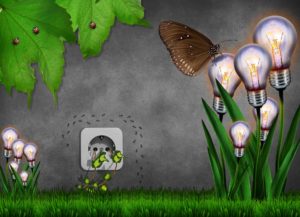With more and more older adults wanting to age in place and maintain their independence as long as possible, caregivers and health professionals are looking for creative solutions to the familiar challenges of ensuring seniors’ ongoing safety and quality of life.
This new generation of aging adults today have a variety of care needs — yet there may not be enough health care workers to meet those needs. A pioneering effort by the European Union aims to address this issue through the use of technologies that promote independent, active, healthy aging.
How Ambient Assisted Living Uses Technology for Seniors
The idea of Ambient Assisted Living is closely related to “welfare technology,” a term coined in the Scandinavian countries, where a variety of welfare services are commonly offered throughout the public sector. According to DAA (Design led Innovations for Active Aging), welfare technology is a general term describing any technology that helps users gain more independence in their daily lives, regardless of illness or physical, mental, or social disability.
However, the goals of the Ambient Assisted Living Joint Programme are far more comprehensive than simply promoting new technologies, addressing important issues such as mobility, independence, social interaction and meaningful activity. The ultimate aim is to enhance the health, autonomy, security and quality of life for older adults, while also supporting families and caregivers.
A Crash Course in Welfare Technology
When it comes to seniors, welfare technology comprises a wide range of items that may help with either specific conditions such as visual impairment, or they may improve quality of life in general — for instance, communication technologies that help seniors stay in touch with their families.
The use of welfare technology still faces a number of barriers and questions. In an individualistic society like the United States, many people have privacy concerns over the collection of personal information. Another concern is ensuring that technology is implemented not in an over-generalized way, but tailored specifically to each individual’s needs and abilities. Not only that, in many places there still isn’t enough of an infrastructure to handle consistent communication, regulations or technological maintenance. And, of course, nobody wants or intends for technology to replace social contact or in-person health care entirely.
6 Ways Welfare Technology in AAL Helps Seniors
While technology cannot wholly substitute for the warmth of human interaction, it can certainly provide assistance with specific day-to-day challenges for many people. The AAL has focused on six specific areas in which welfare technology can help seniors cope with illness, improve mobility, and enhance everyday life. The results of the AAL’s efforts have been innovative, exciting and inspirational — read on for some real-life examples in each of the AAL’s project areas.
Managing and Preventing Chronic Conditions in Seniors
This part of the AAL’s program looked at elderly people with illnesses and other chronic conditions, and solicited proposals for projects that provided a more holistic approach to prevention, care and support. A few of the ideas that resulted:
- AMICA: Aimed at helping patients manage COPD, AMICA combines physiological sensors with data that is self-reported via a user-friendly mobile device. “The system is able to set off medical alarms, modify small aspects of the patients’ treatment program or lifestyle, or even suggest hospitalization.”
- Health@Home: This Bluetooth-based system for people with chronic heart failure uses wearable sensors to transmit vital signs data such as blood pressure to a server at a person’s health care facility, updating the person’s medical records and providing key early alerts to changes in health status.
- HOPE: The HOPE program is an integrated platform for managing a smart home, including devices for communication, security and fall prevention. In particular, it aims to help people with Alzheimer’s live both independently and safely — for instance, by alerting them if an appliance is left on.
Helping Seniors Remain Socially Active
A second objective of the AAL was soliciting proposals “aimed at helping people to be active, joyful and socially connected in the society as they age, from both a societal and personal perspective, effectively contributing to their health, overall quality of life and to social inclusion.” An impressive 23 projects were funded in this area.
- ALICE: Meant to help prevent senior isolation and enhance connectivity, ALICE is a set-top box connected to an older person’s TV, integrating a video camera, microphone and remote with a variety of simple applications for social interaction, including video communication, photo sharing and games.
- FoSIBLE: FoSIBLE promotes social interaction through games, shared interests, physical activity and communication with friends and relatives via a TV-based “Social Media Centre” that is controlled via gestures, tablets or even smart furniture.
- SeniorEngage: Seniors in a particular profession can share their expertise and continue to participate in society post-retirement by using this networking platform to network with other retirees, mentor young professionals and provide advice to business and organizations.
Supporting the Independence of Older Adults
AAL was also concerned with enhancing independence and dignity for seniors in a constantly changing society that increasingly relies on technological literacy. To that end, they called for proposals to help seniors achieve that independence through supporting their mobility, physical wellness, and cognitive health.
- ALFA: Active Living for Alzheimer Patients offers personalized support for people with dementia through a three-part technology: visual stimulation of mirror neurons in Alzheimer patients, an interactive agenda or diary and a movement monitoring system.
- MobileSage: With elderly people staying active and independent for longer into their golden years, they will be looking for user-friendly tech services to help them with anything, any time. MobileSage, a smartphone-based technology, provides “context-sensitive, personalized and location-sensitive tools which allow them to carry out and solve everyday tasks and problems when and where they occur, ‘just-in-time’.”
- vAssist: vAssist would provide voice-controlled home care and communication services to elderly people, particularly those with motor impairments and/or chronic diseases.
Helping with Senior Mobility
Helping seniors remain mobile for as long as possible goes a long way toward fostering a sense of independence and well-being. AAL also looked at proposals for new assistive technologies, as well as devices to help with orientation and navigation.
- CONFIDENCE: With this program, people suffering from mild to moderate dementia are provided with a “virtual companion” on their smartphone that can help them reorient themselves if they are lost, provide location tracking, give voice directions and connect them with family or caregivers.
- E-Stocking: This is just what it sounds like — a compression stocking that is not only equipped with sensors that respond to physiological variations in real time, but also pre-programmed for each specific patient.
- iWalkActive: Many older adults utilize walkers to get around; iWalkActive is a state-of-the-art version with a mobile device dock enabling the user to interact with navigation and assistance services in the cloud using a touch screen, microphone and speaker.
Supporting Activities of Daily Living
This aspect of AAL’s mission targets helping seniors continue to carry out the day-to-day activities they’re used to doing on their own, like bathing, dressing and eating, as well as enabling caregivers to provide that support where necessary.
- ACCESS: In order to address the problem of information sharing between caregivers, family members, and health care professionals, ACCESS software creates a standardized communication system where your senior loved one’s health information is centralized. It also helps manage visits, calls, medication administration and other daily activities.
- Diet4Elders: The goal of this project is to reduce senior malnutrition by using hardware and software tools that monitor and advise seniors on their eating habits, providing nutrition counseling and guidance to help them feed themselves.
- INSPIRATION: This mobile app is a sort of “digital coach” for mental and physical activity. In addition to giving health tips, it prompts the user to do movement exercises, and schedules and records activities that can then be monitored by caregivers.
Encouraging Seniors to Remain Vital in the Community
Seniors may be retired, but they still have plenty of opportunities to contribute their expertise and energy to the community, to society, and to the economy. Staying involved also helps seniors remain active and avoid isolation. The last area of action for AAL concerns the support of “occupation” in the lives of older adults.
- AXO-SUIT: AXO-SUITs are assistive robotic “exoskeletons” that would help seniors with mobility problems perform various everyday physical tasks such as lifting groceries or helping others with volunteer work.
- Elders-Up! This project helps seniors continue to feel involved with their professional skills and networks by enabling them to collaborate with small companies and lend their valuable experience and expertise to a fledgling organization.
- IronHand provides a “smart glove” to address the problems of reduced grip strength and hand function that are common with aging. The IronHand can also provide personalized training and monitoring of hand function.
There is a vast, ever-growing world of technology making it possible for seniors to continue to live independently and well as they age, and making it easier for caregivers to keep track of loved ones without sacrificing their entire lives to do it. As long as initiatives like AAL continue to devote resources to funding these projects, we can hope to see some of these welfare technologies hit the shelves in the upcoming decades.




